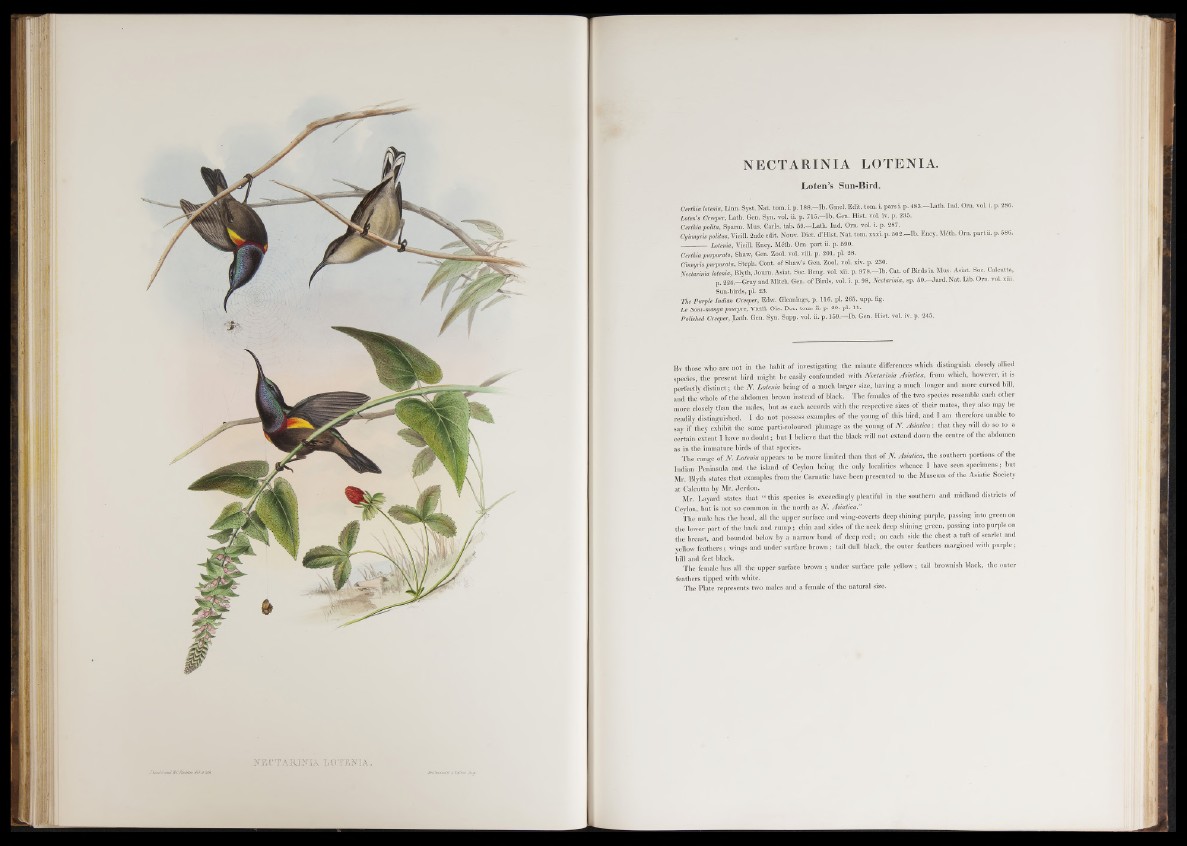
HECTASJiTIA 10TBKIA.
N E C T A R I N I A L O T E N I A .
Loten’s Sun-Bird.
Certhia lotenia, Linn. Syst. Nat. tom. i. p. 188.—Ib. Gmel. Edit. tom. i. pars i. p. 483.—Lath. Ind. Om. vol. i. p. 286.
Loteris Creeper, Lath. Gen. Syn. vol. ii. p. 715.—Ib. Gen. Hist. vol. iv. p. 235.
Certhia pottta, Spann. Mus. Carls, tab. 59.—Lath. Ind. Om. vol. i. p. 287.
Cyimyris politus, Vieill. 2nde edit. Nouv. Diet. d’Hist. Nat. tom. xxxi. p. 502.—Ib. Ency. Meth. Om. partii. p. 586.
Lotenia, Vieill. Ency. M e th . Om. p art ii. p. 590.
Certhia purpurata, Shaw, Gen. Zool. vol. viii. p. 201. pi. 28.
Cinnyris purpurata, Steph. Cont. of Shaw’s Gen. Zool. vol. xiv. p. 230.
Nectarinia lotenia, Blyth, Joum. Asiat. Soe. Beng. vol. xii. p. 978 —Ib. Cat. of Birds in Mus. Asiat. Soc. Calcutta,
p. 224—Gray and Mitch. Gen. of Birds, vol. i. p. 98, Nectarinia, sp. 50.—Jard. Nat. Lib. Ora. vol. xm.
Sun-birds, pi. 23.
The Purple Indian Creeper, Edw. Gleanings, H i pi- 265. upp. fig.
Le Som-manga pourpre, Vieill. Ois. Dor. tom. ii. p. 29. pi. 11.
Polished Creeper, Lath. Gen. Syn. Supp. vol. ii. p. 159.<#tb, Gen. Hist. vol. iv. p. 245.
Bv those who are not in the hahit of investigating the minute differences which distinguish closely allied
species, the present bird might be easily confounded with Nectarinia Asiatica, from which, however, it is
perfectly distinct; the N . Lotenia being of a much lai-ger size, having a much longer and more curved bill,
and the whole of the ahdomen brown instead of black. The females o f the two species resemble each other
more closely than the males, but as each accords with the respective sizes of their mates, they also mpy be
readily distinguished. I do not possess examples of the young of this bird, and I am therefore unable to
say if they exhibit the same parti-coloured plumage as the young of N . Asiatica : that they will do 80 to a
certain extent I have no d oubt; but I believe that the black will not extend down the centre of the abdomen
as in the immature birds of that species.
The range of N . Lotenia appears to be more limited than that of N . Asiatica, the southern portions of the
Indian Peninsula and the island of Ceylon being the only localities whence I have seen specimens; but
Mr. Blyth states that examples from the Carnatic have been p resented to the Museum of the Asiatic Society
a t Calcutta by Mr. Jerdon.
Mr. Layard states that “ this species is exceedingly plentiful in the southern and midland districts of
Ceylon, but is not so common in the north as N . Asiatica.”
The male has the head, all the upper surface and wing-coverts deep shining purple, passing into green on
the lower p art of the back and rum p ; cliin and sides of the neck deep shining green, passing into purple on
the breast, and bounded below by a narrow band of deep r e d ; on each side the chest a tuft of scarlet and
yellow feathers; wings and under surface brown; tail dull black, the outer feathers margined with p u rp le;
bill and feet black.
The female has all the upper surface brown under surface pale yellow ; tail brownish black, the outer
feathers tipped with white.
The Plate represents two males and a female of the natural size.